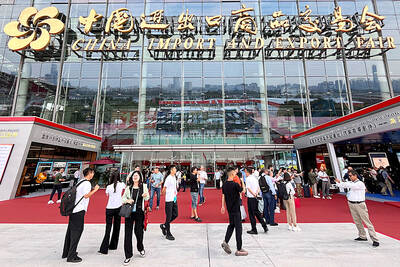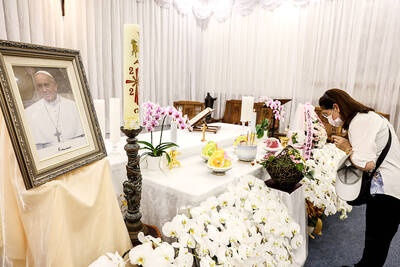The Taipei 228 Memorial Museum is reopening its doors to the public this morning after a 10-month renovation, but its efforts to reveal the truth of the 228 Incident met with challenges as pro--independence activists and family members of the incident’s victims yesterday accused the museum of glorifying the acts of the then-government and distorting the truth with its selection of documents.
The renovated interior design and the documents on display in the permanent exhibition, they said, turned the museum into a bright and beautiful hall that reflected little of the tragic event, and described the then-Chinese Nationalist Party (KMT) regime’s bloody crackdown on demonstrators in 1947 as the government’s exercise of authority.
“My grandfather disappeared shortly after participating in the investigation of the 228 Incident and asking the then-KMT government to stop killing innocent civilians. However, the exhibition said the then-government was trying to restore public order. I am stunned by such an interpretation of history,” said Lee Te-cheng (李德振), whose grandfather’s body was never found after he disappeared.
Touring the museum, Democratic Progressive Party (DPP) Taipei City Councilor Chien Yu-yen (簡余晏), former Academia Historica president Chang Yen-hsien (張炎憲) and former Taipei 228 Memorial Museum director Yeh Po-wen (葉博文) joined Lee in challenging the museum and the Taipei City Government, saying the government had demonstrated arrogance with its interpretation of history and had disrespected the victims and their families.
“What can our children learn about the tragic 228 Incident when all they see is a beautiful room filled with music, great photos of [former dictator] Chiang Kai-shek (蔣介石) and documents that portray the demonstrators as mobs?” Chien said.
Chang said the museum displayed an official order from -Chiang from March 1947 that banned military from taking any revenge measures against civilians following the 228 Incident. However, two other valuable historical documents that showed Chiang ordering then-Taiwan governor Chen Yi (陳儀) to lead troops to Taiwan to handle the accident were not on display.
Yeh said the exhibition also failed to show the exact number of victims of the 228 Incident and failed to discuss Chiang’s responsibility and urged the museum to delay its reopening ceremony and rearrange its exhibit.
Hsieh Ying-tseng (謝英從), director of the Taipei 228 Memorial Museum, yesterday said the museum had included more documents in its exhibition after Chang and other family members of the 228 Incident victims made suggestions.
“The exhibition objectively shows how the incident happened, the then-government’s handling and the victims and their family members’ reactions via historical documents. We do not make any interpretations and we respect different voices,” he said.
According to Hsieh, the museum began the discussion about updating the exhibition in 2007, and invited history experts including National Chengchi University history professor Chen Fang-ming (陳芳明) and Hsu Hsueh-chi (許雪姬), head of Academia Historica’s Institute of Modern History, to discuss the contents of the exhibition.
The museum also held a three-month preview exhibition in 2009 to collect opinions on the exhibition, before closing the museum in April last year for renovation, he said.
President Ma Ying-jeou (馬英九) will attend the reopening ceremony of the museum at 10am today. The museum will be open daily from 10am to 5pm and be closed on Mondays.
The 228 Incident refers to the KMT’s bloody crackdown on demonstrators under Chiang’s administration in 1947 after a woman was beaten for selling contraband cigarettes in Taipei on the night of Feb. 27, 1947.
The beating sparked nationwide disorder and the slaughter of tens of thousands of Taiwanese at the hands of KMT troops.
The KMT did not acknowledge the past mistakes nor offer public apologies over the incident until former president Lee Teng-hui’s (李登輝) administration. Ma has promised to make more effort to uncover the truth of the incident since taking office, and a national museum on the 228 Incident is scheduled to open on Feb. 28 in Taipei.

SECURITY: As China is ‘reshaping’ Hong Kong’s population, Taiwan must raise the eligibility threshold for applications from Hong Kongers, Chiu Chui-cheng said When Hong Kong and Macau citizens apply for residency in Taiwan, it would be under a new category that includes a “national security observation period,” Mainland Affairs Council (MAC) Minister Chiu Chui-cheng (邱垂正) said yesterday. President William Lai (賴清德) on March 13 announced 17 strategies to counter China’s aggression toward Taiwan, including incorporating national security considerations into the review process for residency applications from Hong Kong and Macau citizens. The situation in Hong Kong is constantly changing, Chiu said to media yesterday on the sidelines of the Taipei Technology Run hosted by the Taipei Neihu Technology Park Development Association. With

CARROT AND STICK: While unrelenting in its military threats, China attracted nearly 40,000 Taiwanese to over 400 business events last year Nearly 40,000 Taiwanese last year joined industry events in China, such as conferences and trade fairs, supported by the Chinese government, a study showed yesterday, as Beijing ramps up a charm offensive toward Taipei alongside military pressure. China has long taken a carrot-and-stick approach to Taiwan, threatening it with the prospect of military action while reaching out to those it believes are amenable to Beijing’s point of view. Taiwanese security officials are wary of what they see as Beijing’s influence campaigns to sway public opinion after Taipei and Beijing gradually resumed travel links halted by the COVID-19 pandemic, but the scale of

A US Marine Corps regiment equipped with Naval Strike Missiles (NSM) is set to participate in the upcoming Balikatan 25 exercise in the Luzon Strait, marking the system’s first-ever deployment in the Philippines. US and Philippine officials have separately confirmed that the Navy Marine Expeditionary Ship Interdiction System (NMESIS) — the mobile launch platform for the Naval Strike Missile — would take part in the joint exercise. The missiles are being deployed to “a strategic first island chain chokepoint” in the waters between Taiwan proper and the Philippines, US-based Naval News reported. “The Luzon Strait and Bashi Channel represent a critical access

Pope Francis is be laid to rest on Saturday after lying in state for three days in St Peter’s Basilica, where the faithful are expected to flock to pay their respects to history’s first Latin American pontiff. The cardinals met yesterday in the Vatican’s synod hall to chart the next steps before a conclave begins to choose Francis’ successor, as condolences poured in from around the world. According to current norms, the conclave must begin between May 5 and 10. The cardinals set the funeral for Saturday at 10am in St Peter’s Square, to be celebrated by the dean of the College